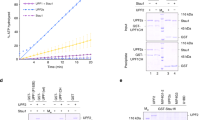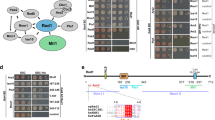Abstract
Nonsense-mediated mRNA decay (NMD) eliminates mRNAs containing a premature translation termination codon through the recruitment of the conserved NMD factors UPF1, UPF2 and UPF3. In humans, a dynamic assembly pathway allows UPF1 to join UPF2 and UPF3 recruited to the mRNA by the exon-junction complex (EJC). Here we show that the recombinant EJC core is sufficient to reconstitute, with the three UPF proteins, a stable heptameric complex on RNA. The EJC proteins MAGOH, Y14 and eIF4AIII provide a composite binding site for UPF3b that serves as a bridge to UPF2 and UPF1. In the UPF trimeric complex, UPF2 and UPF3b cooperatively stimulate both ATPase and RNA helicase activities of UPF1. This work demonstrates that the EJC core is sufficient to stably anchor the UPF proteins to mRNA and provides insights into the regulation of its central effector, UPF1.
This is a preview of subscription content, access via your institution
Access options
Subscribe to this journal
Receive 12 print issues and online access
$189.00 per year
only $15.75 per issue
Buy this article
- Purchase on Springer Link
- Instant access to full article PDF
Prices may be subject to local taxes which are calculated during checkout








Similar content being viewed by others
References
Fasken, M.B. & Corbett, A.H. Process or perish: quality control in mRNA biogenesis. Nat. Struct. Mol. Biol. 12, 482–488 (2005).
Moore, M.J. From birth to death: the complex lives of eukaryotic mRNAs. Science 309, 1514–1518 (2005).
Rehwinkel, J., Raes, J. & Izaurralde, E. Nonsense-mediated mRNA decay: target genes and functional diversification of effectors. Trends Biochem. Sci. 31, 639–646 (2006).
Conti, E. & Izaurralde, E. Nonsense-mediated mRNA decay: molecular insights and mechanistic variations across species. Curr. Opin. Cell Biol. 17, 316–325 (2005).
Behm-Ansmant, I. & Izaurralde, E. Quality control of gene expression: a stepwise assembly pathway for the surveillance complex that triggers nonsense-mediated mRNA decay. Genes Dev. 20, 391–398 (2006).
Amrani, N. et al. A faux 3′–UTR promotes aberrant termination and triggers nonsense-mediated mRNA decay. Nature 432, 112–118 (2004).
Behm-Ansmant, I., Gatfield, D., Rehwinkel, J., Hilgers, V. & Izaurralde, E. A conserved role for cytoplasmic poly(A)-binding protein 1 (PABPC1) in nonsense-mediated mRNA decay. EMBO J. 26, 1591–1601 (2007).
Longman, D., Plasterk, R.H., Johnstone, I.L. & Caceres, J.F. Mechanistic insights and identification of two novel factors in the C. elegans NMD pathway. Genes Dev. 21, 1075–1085 (2007).
Carter, M.S., Li, S. & Wilkinson, M.F. A splicing-dependent regulatory mechanism that detects translation signals. EMBO J. 15, 5965–5975 (1996).
Nagy, E. & Maquat, L.E. A rule for termination-codon position within intron-containing genes: when nonsense affects RNA abundance. Trends Biochem. Sci. 23, 198–199 (1998).
Brocke, K.S., Neu-Yilik, G., Gehring, N.H., Hentze, M.W. & Kulozik, A.E. The human intronless melanocortin 4-receptor gene is NMD insensitive. Hum. Mol. Genet. 11, 331–335 (2002).
Le Hir, H., Izaurralde, E., Maquat, L.E. & Moore, M.J. The spliceosome deposits multiple proteins 20–24 nucleotides upstream of mRNA exon-exon junctions. EMBO J. 19, 6860–6869 (2000).
Ballut, L. et al. The exon junction core complex is locked onto RNA by inhibition of eIF4AIII ATPase activity. Nat. Struct. Mol. Biol. 12, 861–869 (2005).
Tange, T.O., Shibuya, T., Jurica, M.S. & Moore, M.J. Biochemical analysis of the EJC reveals two new factors and a stable tetrameric protein core. RNA 11, 1869–1883 (2005).
Andersen, C.B. et al. Structure of the exon junction core complex with a trapped DEAD-box ATPase bound to RNA. Science 313, 1968–1972 (2006).
Bono, F., Ebert, J., Lorentzen, E. & Conti, E. The crystal structure of the exon junction complex reveals how it maintains a stable grip on mRNA. Cell 126, 713–725 (2006).
Dostie, J. & Dreyfuss, G. Translation is required to remove Y14 from mRNAs in the cytoplasm. Curr. Biol. 12, 1060–1067 (2002).
Lejeune, F., Ishigaki, Y., Li, X. & Maquat, L.E. The exon junction complex is detected on CBP80-bound but not eIF4E-bound mRNA in mammalian cells: dynamics of mRNP remodeling. EMBO J. 21, 3536–3545 (2002).
Tange, T.O., Nott, A. & Moore, M.J. The ever-increasing complexities of the exon junction complex. Curr. Opin. Cell Biol. 16, 279–284 (2004).
Giorgi, C. & Moore, M.J. The nuclear nurture and cytoplasmic nature of localized mRNPs. Semin. Cell Dev. Biol. 18, 186–193 (2007).
Le Hir, H., Gatfield, D., Izaurralde, E. & Moore, M.J. The exon-exon junction complex provides a binding platform for factors involved in mRNA export and nonsense-mediated mRNA decay. EMBO J. 20, 4987–4997 (2001).
Lykke-Andersen, J., Shu, M.D. & Steitz, J.A. Communication of the position of exon-exon junctions to the mRNA surveillance machinery by the protein RNPS1. Science 293, 1836–1839 (2001).
Kashima, I. et al. Binding of a novel SMG-1–UPF1-eRF1-eRF3 complex (SURF) to the exon junction complex triggers UPF1 phosphorylation and nonsense-mediated mRNA decay. Genes Dev. 20, 355–367 (2006).
Kim, V.N., Kataoka, N. & Dreyfuss, G. Role of the nonsense-mediated decay factor hUPF3 in the splicing-dependent exon-exon junction complex. Science 293, 1832–1836 (2001).
Gehring, N.H., Neu-Yilik, G., Schell, T., Hentze, M.W. & Kulozik, A.E. Y14 and hUPF3b form an NMD-activating complex. Mol. Cell 11, 939–949 (2003).
Gehring, N.H. et al. Exon-junction complex components specify distinct routes of nonsense-mediated mRNA decay with differential cofactor requirements. Mol. Cell 20, 65–75 (2005).
Kadlec, J., Izaurralde, E. & Cusack, S. The structural basis for the interaction between nonsense-mediated mRNA decay factors UPF2 and UPF3. Nat. Struct. Mol. Biol. 11, 330–337 (2004).
He, F., Brown, A.H. & Jacobson, A. UPF1p, Nmd2p, and UPF3p are interacting components of the yeast nonsense-mediated mRNA decay pathway. Mol. Cell. Biol. 17, 1580–1594 (1997).
Serin, G., Gersappe, A., Black, J.D., Aronoff, R. & Maquat, L.E. Identification and characterization of human orthologues to Saccharomyces cerevisiae UPF2 protein and UPF3 protein (Caenorhabditis elegans SMG-4). Mol. Cell. Biol. 21, 209–223 (2001).
Kadlec, J., Guilligay, D., Ravelli, R.B. & Cusack, S. Crystal structure of the UPF2-interacting domain of nonsense-mediated mRNA decay factor UPF1. RNA 12, 1817–1824 (2006).
Applequist, S.E., Selg, M., Raman, C. & Jack, H.M. Cloning and characterization of HUPF1, a human homolog of the Saccharomyces cerevisiae nonsense mRNA-reducing UPF1 protein. Nucleic Acids Res. 25, 814–821 (1997).
Weng, Y., Czaplinski, K. & Peltz, S.W. Identification and characterization of mutations in the UPF1 gene that affect nonsense suppression and the formation of the UPF protein complex but not mRNA turnover. Mol. Cell. Biol. 16, 5491–5506 (1996).
Cheng, Z., Muhlrad, D., Lim, M.K., Parker, R. & Song, H. Structural and functional insights into the human UPF1 helicase core. EMBO J. 26, 253–264 (2007).
Singleton, M.R., Dillingham, M.S. & Wigley, D.B. Structure and mechanism of helicases and nucleic acid translocases. Annu. Rev. Biochem. 76, 23–50 (2007).
Czaplinski, K., Weng, Y., Hagan, K.W. & Peltz, S.W. Purification and characterization of the UPF1 protein: a factor involved in translation and mRNA degradation. RNA 1, 610–623 (1995).
Weng, Y., Czaplinski, K. & Peltz, S.W. Genetic and biochemical characterization of mutations in the ATPase and helicase regions of the UPF1 protein. Mol. Cell. Biol. 16, 5477–5490 (1996b).
Bhattacharya, A. et al. Characterization of the biochemical properties of the human UPF1 gene product that is involved in nonsense-mediated mRNA decay. RNA 6, 1226–1235 (2000).
Kunz, J.B., Neu-Yilik, G., Hentze, M.W., Kulozik, A.E. & Gehring, N.H. Functions of hUPF3a and hUPF3b in nonsense-mediated mRNA decay and translation. RNA 12, 1015–1022 (2006).
He, F., Brown, A.H. & Jacobson, A. Interaction between Nmd2p and UPF1p is required for activity but not for dominant-negative inhibition of the nonsense-mediated mRNA decay pathway in yeast. RNA 2, 153–170 (1996).
Weng, Y., Czaplinski, K. & Peltz, S.W. ATP is a cofactor of the UPF1 protein that modulates its translation termination and RNA binding activities. RNA 4, 205–214 (1998).
Kim, J.L. et al. Hepatitis C virus NS3 RNA helicase domain with a bound oligonucleotide: the crystal structure provides insights into the mode of unwinding. Structure 6, 89–100 (1998).
Shibuya, T., Tange, T.O., Stroupe, M.E. & Moore, M.J. Mutational analysis of human eIF4AIII identifies regions necessary for exon junction complex formation and nonsense-mediated mRNA decay. RNA 12, 360–374 (2006).
Fribourg, S., Gatfield, D., Izaurralde, E. & Conti, E. A novel mode of RBD-protein recognition in the Y14-Mago complex. Nat. Struct. Biol. 10, 433–439 (2003).
Forler, D. et al. An efficient protein complex purification method for functional proteomics in higher eukaryotes. Nat. Biotechnol. 21, 89–92 (2003).
Bono, F. et al. Molecular insights into the interaction of PYM with the Mago-Y14 core of the exon junction complex. EMBO Rep. 5, 304–310 (2004).
Chandran, V. et al. Recognition and cooperation between the ATP-dependent RNA helicase RhlB and ribonuclease RNase E. J. Mol. Biol. 367, 113–132 (2007).
Czaplinski, K. et al. The surveillance complex interacts with the translation release factors to enhance termination and degrade aberrant mRNAs. Genes Dev. 12, 1665–1677 (1998).
Kim, Y.K., Furic, L., Desgroseillers, L. & Maquat, L.E. Mammalian Staufen1 recruits UPF1 to specific mRNA 3UTRs so as to elicit mRNA decay. Cell 120, 195–208 (2005).
Kaygun, H. & Marzluff, W.F. Regulated degradation of replication-dependent histone mRNAs requires both ATR and UPF1. Nat. Struct. Mol. Biol. 12, 794–800 (2005).
Chan, W.K. et al. An alternative branch of the nonsense-mediated decay pathway. EMBO J. 26, 1820–1830 (2007).
Cordin, O., Tanner, N.K., Doere, M., Linder, P. & Banroques, J. The newly discovered Q motif of DEAD-box RNA helicases regulates RNA-binding and helicase activity. EMBO J. 23, 2478–2487 (2004).
Acknowledgements
We thank E. Conti, (MPI of Biochemistry, Martinsried, Germany), S. Cusack (EMBL, Grenoble, France) and F. Lejeune (IGMM-CNRS, Montpellier, France) for UPF cDNAs. We are grateful to B. Marchadier, B. Séraphin and his laboratory for technical assistance, helpful advice and discussions. We acknowledge S. Camier, E. Conti, M. Dreyfus and A. Expert-Bezançon for carefully reading the manuscript. This work was supported in part by the Centre National de la Recherche Scientifique (CNRS), La Ligue Contre le Cancer, the Research Ministry (grant ACI-jeunes chercheurs) and the Agence Nationale de la Recherche (ANR). F.B. was supported by the Max Planck Institute of Biochemistry.
Author information
Authors and Affiliations
Contributions
L.B. initiated this work; H.C., L.B., F.B. and H.L.H. cloned cDNAs, and expressed and purified recombinant proteins; L.B., H.C. and F.B. performed protein binding assays; F.B. carried out RNA protection and ATPase assays; H.C. carried out duplex unwinding assays. H.L.H. provided resources, conceived and directed the project and wrote the article.
Corresponding author
Supplementary information
Supplementary Text and Figures
Supplementary Figures 1–3 (PDF 1801 kb)
Rights and permissions
About this article
Cite this article
Chamieh, H., Ballut, L., Bonneau, F. et al. NMD factors UPF2 and UPF3 bridge UPF1 to the exon junction complex and stimulate its RNA helicase activity. Nat Struct Mol Biol 15, 85–93 (2008). https://doi.org/10.1038/nsmb1330
Received:
Accepted:
Published:
Issue Date:
DOI: https://doi.org/10.1038/nsmb1330
This article is cited by
-
Nonsense-mediated mRNA decay pathway in plants under stress: general gene regulatory mechanism and advances
Planta (2024)
-
N6-Methyladenosine-modified lncRNA LINREP promotes Glioblastoma progression by recruiting the PTBP1/HuR complex
Cell Death & Differentiation (2023)
-
Characterization of a rhabdomyosarcoma reveals a critical role for SMG7 in cancer cell viability and tumor growth
Scientific Reports (2023)
-
Nonsense-Mediated mRNA Decay: Mechanistic Insights and Physiological Significance
Molecular Biotechnology (2023)
-
Intron retention coupled with nonsense-mediated decay is involved in cellulase biosynthesis in cellulolytic fungi
Biotechnology for Biofuels and Bioproducts (2022)



